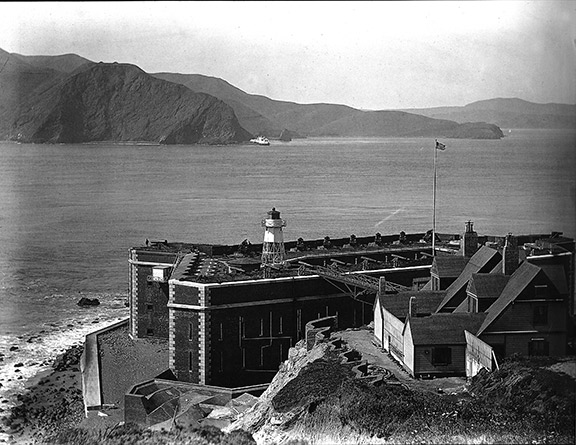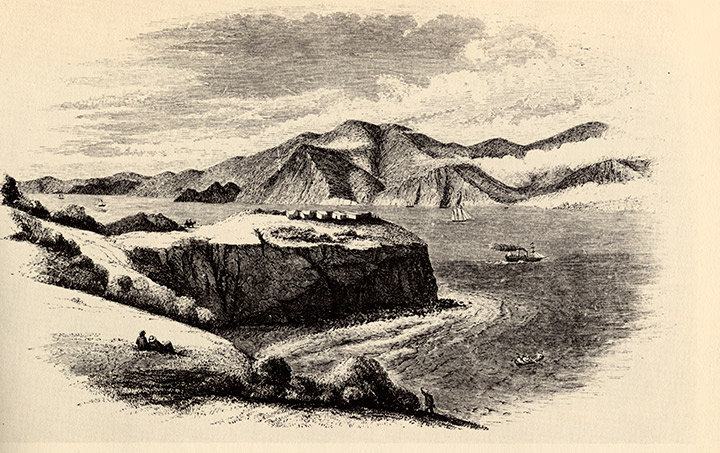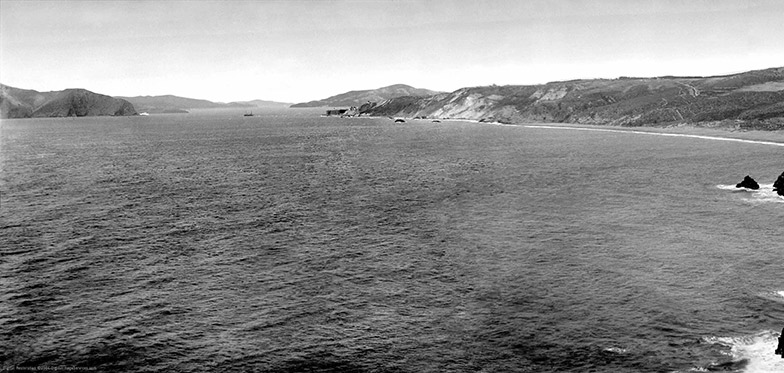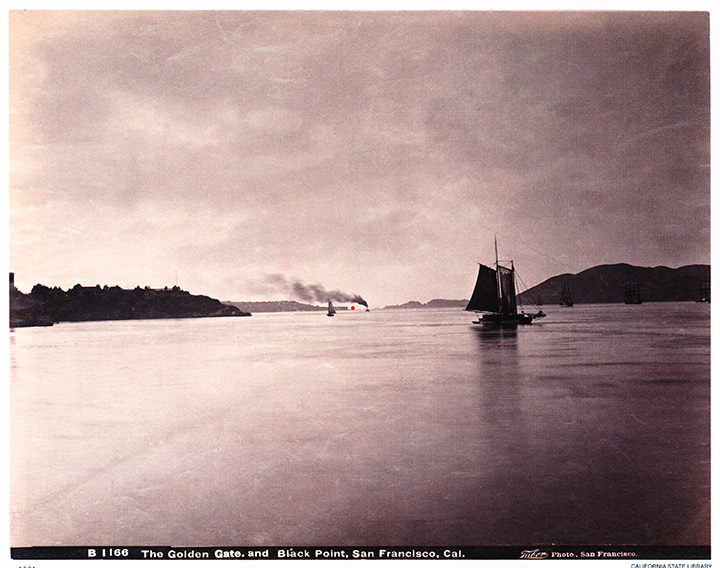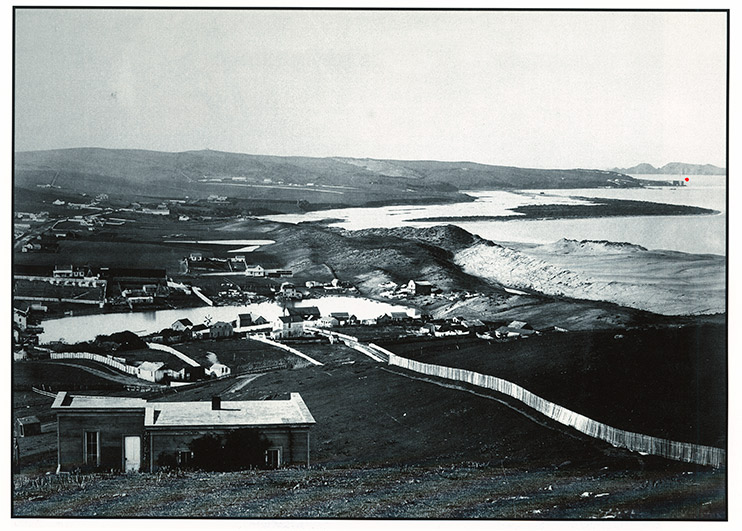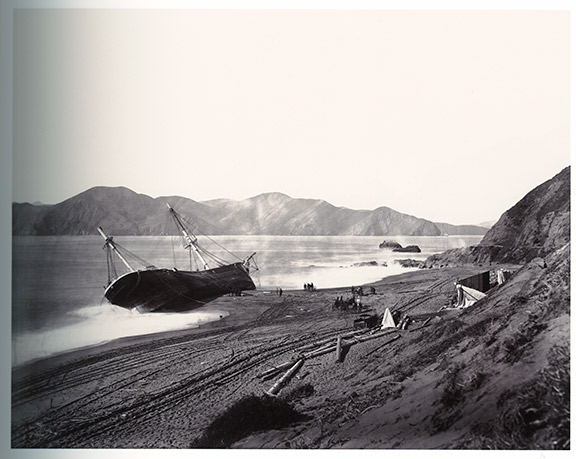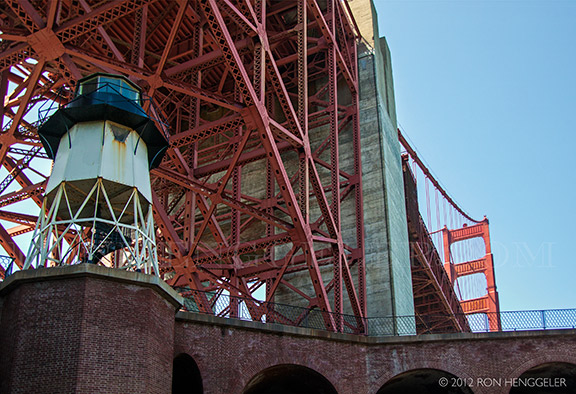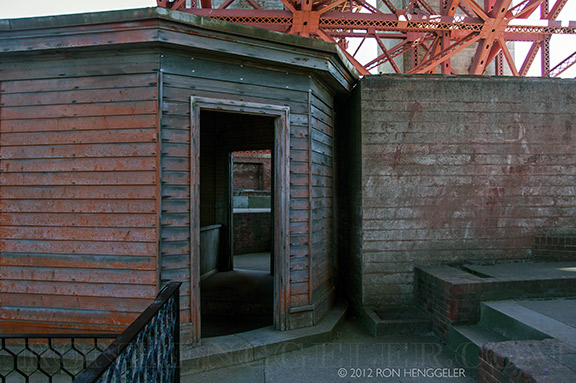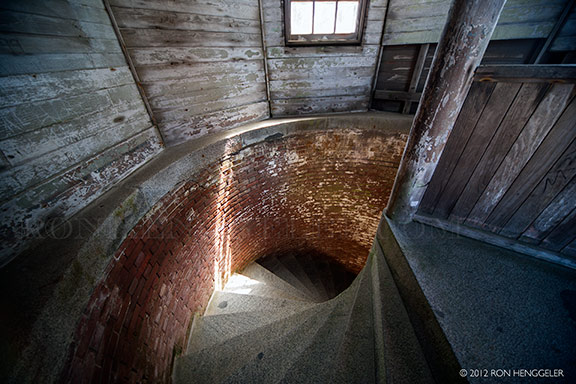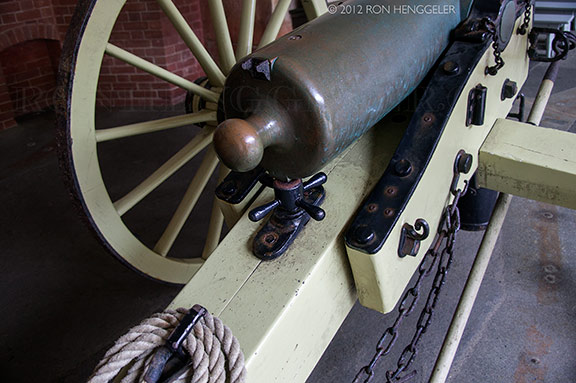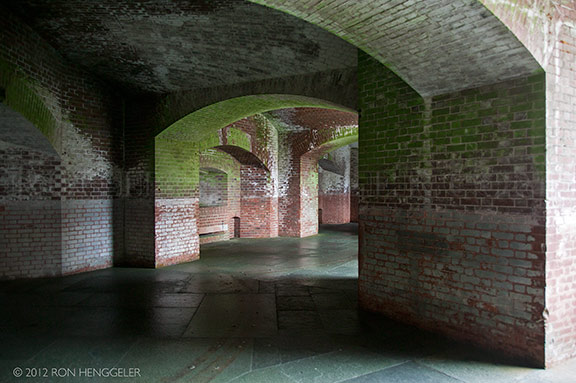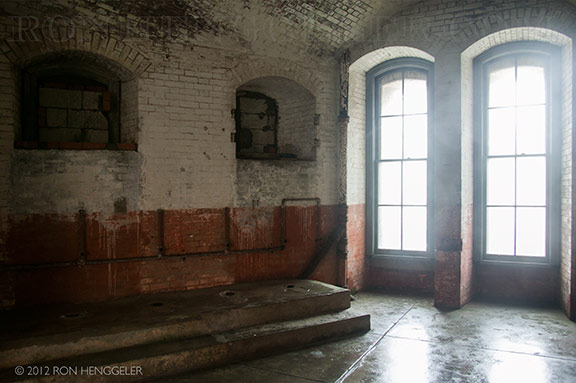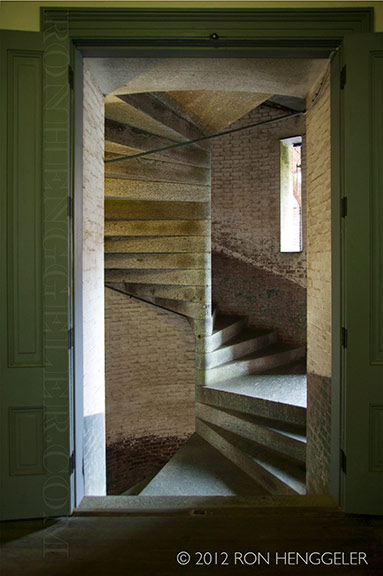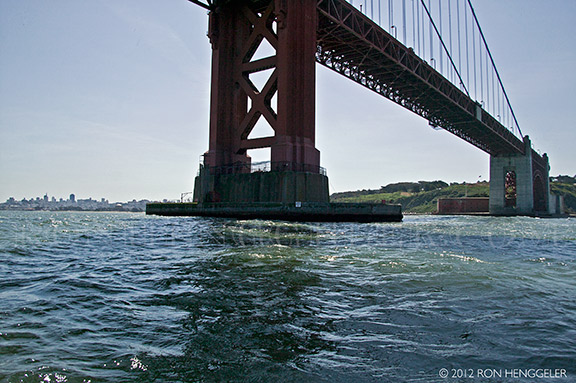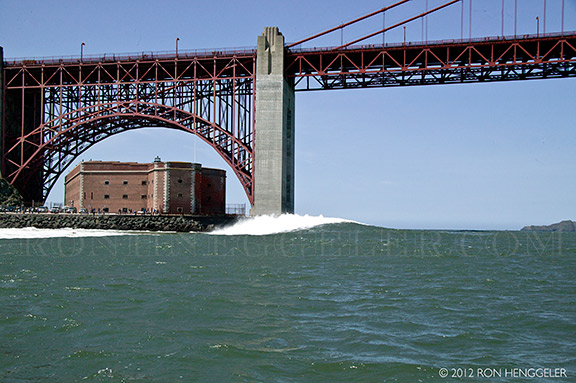RON HENGGELER |
7/29/14
Fort Point in San Francisco
Fort Point was built between 1853 and 1861 by the U.S. Army Engineers as part of a defense system of forts planned for the protection of San Francisco Bay. Designed at the height of the Gold Rush, the fort and its companion fortifications would protect the Bay's important commercial and military installations against foreign attack.
The Fort has been called "the pride of the Pacific," "the Gibraltar of the West Coast," and "one of the most perfect models of masonry in America." When construction began during the height of the California Gold Rush, Fort Point was planned as the most formidable deterrence America could offer to a naval attack on California. Although its guns never fired a shot in anger, the "Fort at Fort Point" as it was originally named has witnessed Civil War, obsolescence, earthquake, bridge construction, reuse for World War II, and preservation as a National Historic Site. |
1. Sallyport |
This image shows the coastal cliff that existed before Fort Point was built. The U.S. Army Corps of Engineers began work on Fort Point in 1853. Plans specified that the lowest tier of artillery be as close as possible to water level so cannonballs could ricochet across the water's surface to hit enemy ships at the waterline. Workers blasted the 90-foot cliff at the construction site, down to 15 feet above sea level. |
This is the view from outside the Gate in 1895. |
Another view of the distant Fort Point but this time from east of the Gate and on San Francisco Bay. |
A mid-1800’s view from Russian Hill in San Francisco looking west. |
The wreck of the Viscata along the coast outside the Gate and near Fort Point in 1868 |
In the late 1930s, plans for the construction of the Golden Gate Bridge also involved plans for the demolition of Fort Point. |
Fortunately, Chief Engineer Joseph Strauss recognized the architectural value of the Fort and created a special engineer arch which allowed the construction of the bridge to occur safely over the Fort. |
The fort was built in the Army's traditional "Third System" style of military architecture (a standard adopted in the 1820s), and would be the only fortification of this impressive design constructed west of the Mississippi River. This fact bears testimony to the importance the military gave San Francisco and the gold fields during the 1850s. |
The structure was protected by 7-foot thick walls and had multi-tiered casemated construction typical of Third System forts. While there were more than 30 such forts on the East Coast, Fort point was the only one of its type built on the West Coast. |
A surfer in the summer fog waiting for a wave near Fort Point. |
During World War II, Fort Point was once again used as temporary housing for soldiers. |
During World War II, Fort Point was occupied by about 100 soldiers who manned searchlights and rapid-fire cannon mounted atop the fort as part of the protection of the submarine net strung across the entrance to the Bay. |
Fort Point never had to fire its guns in defense during the Civil War; the war came and went, without the Confederate Army ever launching an assault on the Bay. |
Work on Fort Point began in 1853. Since few local sources of building materials were available, granite was imported from as far away as China before engineers gave up the idea of stone. Some eight million bricks were made in a brickyard nearby. |
A view of Fort Point and the anchorage of the Golden Gate Bridge. |
Its beautifully arched casemates display the art of the master brick mason from the Civil War period. |
Graffiti on the wall inside Fort Point. |
Granite for building the fort and the seawall came from China, Point Reyes, and the Sierra Mountains. |
Fort Point never had to fire its guns in defense during the Civil War; the war came and went, without the Confederate Army ever launching an assault on the Bay. |
Although the Fort never came under attack, its mere presence created a deterrent that would have weighed heavily in the minds of those who sought to undermine the Union's grip on the Pacific Coast. |
A view of Fort Point from the pedestrian walkway on the Golden Gate Bridge. |
A crew of 200, many unemployed miners, labored for eight years on the fort. In 1861, with war looming, the army mounted the fort's first cannon. |
A view of Point Bonita across the Gate, seen through a damaged wall on the second tier at Fort Point. |
The view from atop the West Bastion looking north into the trestlework of the Golden Gate Bridge. |
Algae on a second tier brick wall |
A view of the Golden Gate Bridge seen through a cannon’s porthole. |
Because the land on which the fort stands was cut down to within 15 feet of the water, a seawall was needed for protection. This 1,500-foot-long wall is an impressive engineering feat. Granite stones were fitted together and the spaces between them sealed with strips of lead. Completed in 1869, the seawall held fast for more than 100 years against the Golden Gate's powerful waves, until it began to give way in the 1980s. The National Park Service rebuilt the wall and placed boulders seaward to deflect the force of the waves. |
Unbelievably masterful brickwork on the second tier |
After World War II, the movement to preserve Fort Point for its historic and architectural value began to grow. |
A northwesterly view of the granite seawall and the bridge’s anchorage. |
A window on the first tier |
Signage on the first tier |
The fort was designed to mount 126 massive cannon. Rushed to completion at the beginning of the Civil War, Fort Point was first garrisoned in February of 1861 by Company I, 3rd U.S. Artillery Regiment. |
Between 1933 and 1937 the fort was used as a base of operations for the construction of the Golden Gate Bridge. |
Looking south at the granite seawall and the bridge’s anchorage. |
First tier masonry |
The lighthouse and the arched trestlework of the Golden Gate Bridge |
In 1926 the American Institute of Architects proposed preserving the fort for its outstanding military architecture. Funds were unavailable, and the ideas languished. Plans for the Golden Gate Bridge in the 1930s called for the fort's removal, but Chief Engineer Joseph Strauss redesigned the bridge to save the fort. "While the old fort has no military value now," Strauss said, "it remains nevertheless a fine example of the mason's art.... It should be preserved and restored as a national monument." The fort is situated directly below the southern approach to the bridge, underneath an arch that supports the roadway. |
This is the third lighthouse built at this site- a natural promontory from which to guide mariners through wasters that can be treacherous in fog. The first was demolished shortly after construction in 1852 to make way for Fort Point. The second, north of the fort at the tip of the point suffered from constant erosion. The present lighthouse was used from 1864 until 1934, when the foundation for the Golden Gate Bridge blocked its light. |
Second tier, directly below the lighthouse |
Second tier |
A detail of one of the masterful stone-worked staircases |
Fort Point has guarded the Golden Gate since the Civil War. Today visitors come to Fort Point National Historic Site, managed by the National Park Service, for amazing Golden Gate Bridge views and to learn about Army architecture and history. |
Top of the staircase leading out onto the fort’s Barbette Tier |
Although work began in 1853, the completion of Fort Point was delayed because of the cost and complexity of building multi-storied tiers of arched brick casemates, which would also need to withstand the severe storms of the Pacific Ocean. By 1860, the fort had been raised to the barbette (top) tier and could accommodate ninety cannons yet to be installed. |
Cannon balls on the the floor of the interior courtyard |
Admission to Fort Point is free. Many tours and events happen here, and they are listed on the sallyport program board at the entrance. Depending on the day and time of year, visitors may encounter Civil War re-enactors, a candlelight tour, or even a pier crabbing demonstration. Videos on Fort Point history and Golden Gate Bridge construction are shown in the theater. Rooms in the fort house exhibits on Buffalo Soldiers, women at war, and more. |
A southerly view of the Golden Gate Bridge seen from the Barbette Tier |
During the Civil War, as many as 500 men from the 3rd U.S. Artillery, the 9th U.S. Infantry, and the 8th California Volunteer Infantry were garrisoned at Fort Point. Stationed several thousand miles from the major theaters of combat, the men spent their days in a routine of drills, artillery practice, inspections, sentry duty, and maintenance chores. |
Fort Point and the Golden Gate Bridge seen from Crissy Field in the Presidio. |
Enlisted men bunked 24 to a casemate on the third tier; officers had single or double quarters on the floor below. To supplement coal fuel, soldiers gathered driftwood from the shore to stay warm. |
The granite staircase |
|
|
|
|
At its greatest strength, the fort mounted 102 cannon. In addition, the fort had "hotshot" furnaces, which allowed iron cannon balls to heated red hot, loaded into a cannon, and fired at wooden ships to set them ablaze. |
|
A masterpiece of stonework and masonry. |
A view from just outside the Gate near the South Tower.
Fort Point is on the shore in the distance. |
Fort Point stands as an example of Third System fortification architecture. The fort had three tiers of casemates (vaulted rooms housing cannon), and a barbette tier on the roof with addition guns and a sod covering to absorb the impact of enemy cannon fire. |
A view from just inside the Gate east of the South Tower of the Golden Gate Bridge. |
The circular stairs at Fort Point are masterpieces of stonework and masonry. |
|
|
|
Newsletters Index: 2015, 2014, 2013, 2012, 2011, 2010, 2009, 2008, 2007, 2006
Photography Index | Graphics Index | History Index
Home | Gallery | About Me | Links | Contact
© 2015 All rights reserved
The images are not in the public domain. They are the sole property of the
artist and may not be reproduced on the Internet, sold, altered, enhanced,
modified by artificial, digital or computer imaging or in any other form
without the express written permission of the artist. Non-watermarked copies of photographs on this site can be purchased by contacting Ron.
